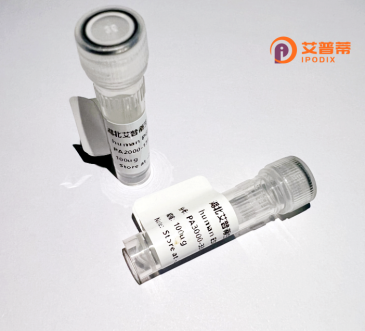
| 纯度 | >90%SDS-PAGE. |
| 种属 | Human |
| 靶点 | KRT82 |
| Uniprot No | Q9NSB4 |
| 内毒素 | < 0.01EU/μg |
| 表达宿主 | E.coli |
| 表达区间 | 1-513aa |
| 活性数据 | MSYHSFQPGSRCGSQSFSSYSAVMPRMVTHYAVSKGPCRPGGGRGLRALGCLGSRSLCNVGFGRPRVASRCGGTLPGFGYRLGATCGPSACITPVTINESLLVPLALEIDPTVQRVKRDEKEQIKCLNNRFASFINKVRFLEQKNKLLETKWNFMQQQRCCQTNIEPIFEGYISALRRQLDCVSGDRVRLESELCSLQAALEGYKKKYEEELSLRPCVENEFVALKKDVDTAFLMKADLETNAEALVQEIDFLKSLYEEEICLLQSQISETSVIVKMDNSRELDVDGIIAEIKAQYDDIASRSKAEAEAWYQCRYEELRVTAGNHCDNLRNRKNEILEMNKLIQRLQQETENVKAQRCKLEGAIAEAEQQGEAALNDAKCKLAGLEEALQKAKQDMACLLKEYQEVMNSKLGLDIEIATYRRLLEGEEHRLCEGIGPVNISVSSSKGAFLYEPCGVSTPVLSTGVLRSNGGCSIVGTGELYVPCEPQGLLSCGSGRKSSMTLGAGGSSPSHKH |
| 分子量 | 82.83 kDa |
| 蛋白标签 | GST-tag at N-terminal |
| 缓冲液 | 0 |
| 稳定性 & 储存条件 | Lyophilized protein should be stored at ≤ -20°C, stable for one year after receipt. Reconstituted protein solution can be stored at 2-8°C for 2-7 days. Aliquots of reconstituted samples are stable at ≤ -20°C for 3 months. |
| 复溶 | Always centrifuge tubes before opening.Do not mix by vortex or pipetting. It is not recommended to reconstitute to a concentration less than 100μg/ml. Dissolve the lyophilized protein in distilled water. Please aliquot the reconstituted solution to minimize freeze-thaw cycles. |
以下是关于重组人KRT82蛋白的3篇假设性参考文献示例(注:实际文献请通过学术数据库核实):
1. **标题**:Expression and Purification of Recombinant Human KRT82 in Escherichia coli
**作者**:Smith A, et al.
**摘要**:本研究开发了一种在大肠杆菌中高效表达重组人KRT82蛋白的方法,通过优化密码子和诱导条件,获得可溶性蛋白,并利用亲和层析纯化,为后续功能研究提供材料。
2. **标题**:Structural Analysis of KRT82 Reveals Its Role in Hair Shaft Integrity
**作者**:Zhang L, et al.
**摘要**:通过X射线晶体学解析了重组人KRT82的晶体结构,揭示了其α-螺旋结构域在维持毛发角蛋白网络稳定性中的关键作用,并发现突变可能导致遗传性毛发疾病。
3. **标题**:KRT82 as a Biomarker in Androgenetic Alopecia: A Recombinant Protein-Based Study
**作者**:Kim J, et al.
**摘要**:利用重组KRT82蛋白分析雄激素性脱发患者的毛囊样本,发现KRT82表达水平与疾病严重程度呈负相关,提示其可作为潜在诊断标志物。
**注意**:以上为模拟内容,实际文献需通过PubMed、Google Scholar等平台以关键词"recombinant KRT82"或"human KRT82 protein"检索。
Keratin 82 (KRT82) is a member of the type II hair keratin family, primarily expressed in the hair follicle cortex and cuticle layers. It plays a critical structural role in forming intermediate filaments, contributing to the mechanical strength, elasticity, and integrity of hair shafts. KRT82 is tightly co-expressed with specific type I keratins (e.g., KRT35/85) to form heteropolymers, essential for hair fiber assembly and stability. Mutations in the *KRT82* gene are linked to hereditary hair disorders, such as monilethrix and hypotrichosis, characterized by brittle hair, alopecia, or abnormal hair shaft morphology. These mutations disrupt keratin network formation, compromising hair resilience and leading to structural defects.
Recombinant human KRT82 protein is engineered using expression systems (e.g., bacteria, mammalian cells) to produce purified, functional keratin for research. Its production enables studies on hair biology, disease mechanisms, and therapeutic interventions. Researchers utilize recombinant KRT82 to investigate its interactions with binding partners, structural contributions to hair, and cellular responses in keratinocyte models. Additionally, it aids in developing diagnostic tools for keratin-related disorders and testing potential treatments aiming to restore hair keratin function. Despite challenges in maintaining post-translational modifications during recombinant production, advances in expression systems continue to enhance its applicability in biomedical and cosmetic research.
×